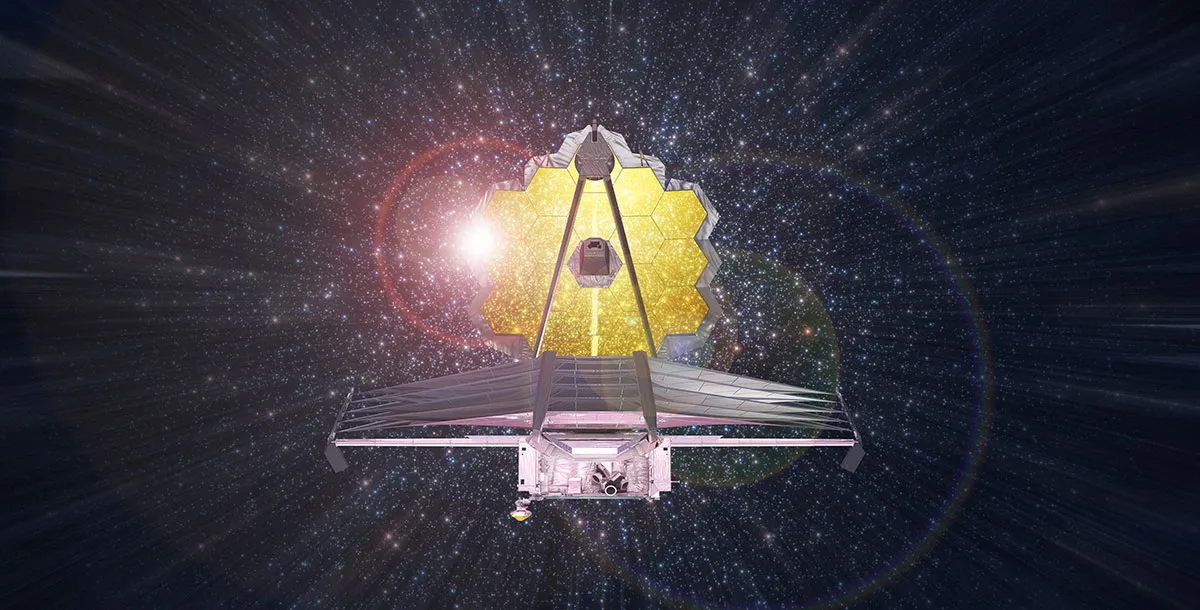“From a tropical rainforest to the edge of time itself, James Webb begins a voyage back to the birth of the Universe” – so went the launch narration when astronomy’s latest superpowered space explorer, the James Webb Space Telescope (JWST), lifted off from French Guiana on Christmas Day. Like most launch announcements, it employed a bit of poetic license to add to the drama. But now that JWST is settled into its orbit and sending back its first calibration images, we might well ask: what will this instrument tell us about the past, and how does that even work?
Characterising a telescope as a time machine is both over- and under-stating its abilities. The telescope itself doesn’t travel through time, but what it does is much more profound than just giving us clues about the past (as, for instance, an archeological dig, or the discovery of an ancient relic would).
Telescopes peering out to distant reaches of the Universe can see our cosmic history, directly. JWST can voyage back to “the edge of time” not by actually going anywhere, but by sending us direct images of some of the earliest moments of the Universe – showing us what it would have looked like if we had actually been there, more than 13 billion years ago, watching the first galaxies form. It’s able to do this partly because of the technology, which includes extraordinarily sensitive sensors and a 6.5-meter primary mirror, and partly because of this one weird trick enabled by Einstein’s relativity.
One of the foundational principles of relativity is that everything you see is in the past. There’s nothing special about telescopes in that regard. It is, in fact, impossible to see the present moment at all. Because light takes time to travel (about a second for every 300,000 kilometers), the image you see of a distant thing has already aged by the time it’s reached you – you’re seeing the thing as it was some time in the past.
It’s not noticeable in daily life because light speed is so fast that when you look at something on the other side of the room, it’s only a handful of nanoseconds in the past, from your perspective. But a space telescope can see distant stars whose light has been travelling for hundreds or thousands of years, and galaxies so far away we’re seeing them as they were billions of years ago.
With the Hubble Space Telescope, we’ve already been able to watch galaxies shine and stars explode within the first few billion years after the Big Bang itself. Hubble has even caught glimpses of especially bright galaxies in only the first few hundred million years – at a time when the cosmos was only just beginning to become awash with starlight.

By studying those images, we’re learning about the conditions of the Universe back then: how much hotter and more crowded it was, how much of the ambient gas was ionised by the light of the newborn stars, how matter was coming together to form the galaxies hosting those stars.
And because our own cosmic neighbourhood doesn’t appear to be unusual in the grand cosmic scheme of things, learning about the early development of some distant part of the cosmos is also telling us about our own past. And the more “ordinary” that part of the cosmos is, the closer we are to observing the origins of everything around us now.
Caitlin Casey, an astronomer at the University of Texas at Austin, who will be among the first to use JWST to study the distant cosmos, knows just how much JWST’s giant mirror and high sensitivity matters.
“The main thing that's different is that JWST will go a factor of 100 times deeper than any existing images we have using ground-based telescopes or Hubble,” she explains. “It's a HUGE gain in sensitivity, which allows us to increase the number of early Universe [first billion years] galaxies known by factors of 100.”
Soon, we’ll be able to see more than just the brightest and rarest representatives of the first generation of galaxies. With JWST, we’ll be watching the very first collections of stars coming together all across the cosmos, lighting up their surroundings and setting the stage for the vast and varied Universe we see around us today.
As astronomers, we hope that JWST will finally answer some of our most pressing questions about the origins of structure in the Universe. But even more than that, we hope that this new view of the deepest reaches of our cosmic history will present us with new questions we didn’t even know enough to ask.
Read more about JWST:
